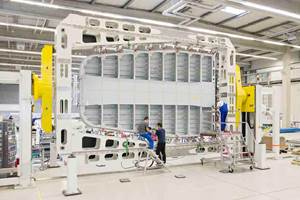Unsaturated polyester resin exhibits flame-retardant properties
CAMX 2024: Polynt is demonstrating its halogen-free A 6104 A resin at the Composites One Demo Booth in the making of a battery tray using a silicone bag closed mold process.
Share
Polynt (Carpentersville, Ill., U.S.) is featuring a novel flame-retardant polyester resin. Polynt A 6104 A is a pre-promoted, halogen-free unsaturated polyester formulated for use in either open or closed molding applications requiring flame retardancy. When combined with ATH filler, Polynt A 6104 A can be used to produce parts meeting flame spread and smoke requirements for the transportation industry, including rail and mass transit.
Polynt A 6104 A polyester resin is featured in the Composite One (Schaumburg, Ill., U.S.) Demo Zone as part of the Land Demonstration. Here the resin is being used to make a battery tray using a silicone bag closed mold process. The fabricated part made is intended to demonstrate the ease of use, flowability, rapid fill rate and ambient cure of Polynt A 6104 A. The battery tray is also demonstrating the concept of using this resin for articles needed in the growing transportation market. Polynt technical service representatives are available at the Demo Zone or in the company’s booth to answer any questions regarding the resin, laminate schedule, tooling or handling of the material for this demonstration.
Composite structures made with Polynt A 6104 A have been tested to meet various flame and smoke requirements including ASTM E162-08, ASTM E662, BSS 7239, ASTM E1354 and Docket 90-A. Polynt has also developed guidelines for fabricators for filler recommendations, cure rates at various processing temperatures, filled resin viscosity profiles, initiator levels required and laminate construction. Polynt also has available mechanical profiles available for either hand layup laminates or infusion laminates.
In addition, parts fabricated with Polynt A 6104 A are said to have improved cosmetics due to the improved fiberglass pattern print-through resistance. The good reactivity and higher heat distortion temperature of the resin reduces cosmetic refinishing on the final parts even if parts are post-cured, according to the company. The viscosity profile of the resin can also enable high filler loadings (20-38%) of ATH while maintaining ease of flow and consistent curing.
Related Content
-
Plant tour: Airbus, Illescas, Spain
Airbus’ Illescas facility, featuring highly automated composites processes for the A350 lower wing cover and one-piece Section 19 fuselage barrels, works toward production ramp-ups and next-generation aircraft.
-
From the CW Archives: Airbus A400M cargo door
The inaugural CW From the Archives revisits Sara Black’s 2007 story on out-of-autoclave infusion used to fabricate the massive composite upper cargo door for the Airbus A400M military airlifter.
-
Development of a composite liquid hydrogen tank for commercial aircraft
Netherlands consortium advances cryogenic composites testing, tank designs and manufacturing including AFP, hybrid winding, welding of tank components and integrated SHM and H2 sensors for demonstrators in 2025.
Related Content
Plant tour: Airbus, Illescas, Spain
Airbus’ Illescas facility, featuring highly automated composites processes for the A350 lower wing cover and one-piece Section 19 fuselage barrels, works toward production ramp-ups and next-generation aircraft.
Read MoreFrom the CW Archives: Airbus A400M cargo door
The inaugural CW From the Archives revisits Sara Black’s 2007 story on out-of-autoclave infusion used to fabricate the massive composite upper cargo door for the Airbus A400M military airlifter.
Read MoreDevelopment of a composite liquid hydrogen tank for commercial aircraft
Netherlands consortium advances cryogenic composites testing, tank designs and manufacturing including AFP, hybrid winding, welding of tank components and integrated SHM and H2 sensors for demonstrators in 2025.
Read MoreCombining multifunctional thermoplastic composites, additive manufacturing for next-gen airframe structures
The DOMMINIO project combines AFP with 3D printed gyroid cores, embedded SHM sensors and smart materials for induction-driven disassembly of parts at end of life.
Read MoreRead Next
Next-gen fan blades: Hybrid twin RTM, printed sensors, laser shock disassembly
MORPHO project demonstrates blade with 20% faster RTM cure cycle, uses AI-based monitoring for improved maintenance/life cycle management and proves laser shock disassembly for recycling.
Read MoreCutting 100 pounds, certification time for the X-59 nose cone
Swift Engineering used HyperX software to remove 100 pounds from 38-foot graphite/epoxy cored nose cone for X-59 supersonic aircraft.
Read MoreCeramic matrix composites: Faster, cheaper, higher temperature
New players proliferate, increasing CMC materials and manufacturing capacity, novel processes and automation to meet demand for higher part volumes and performance.
Read More






